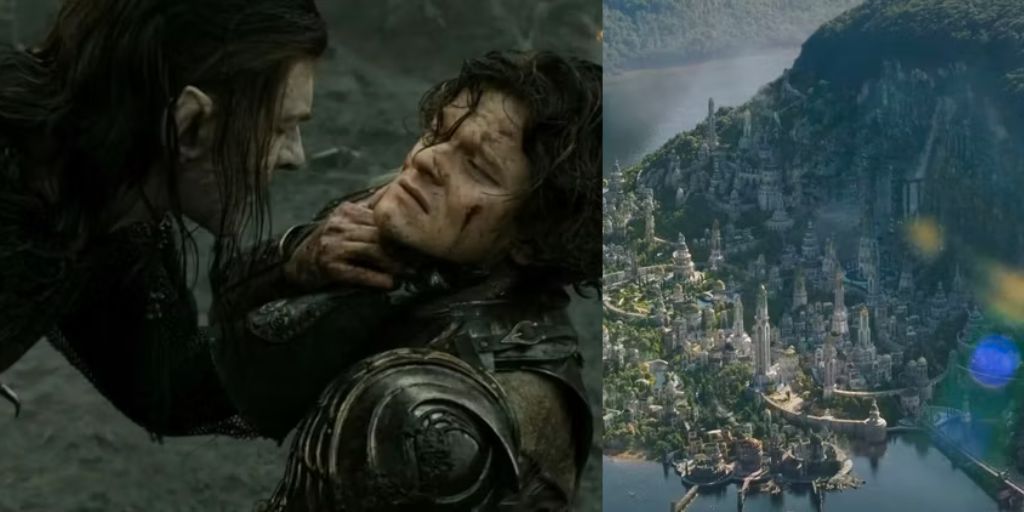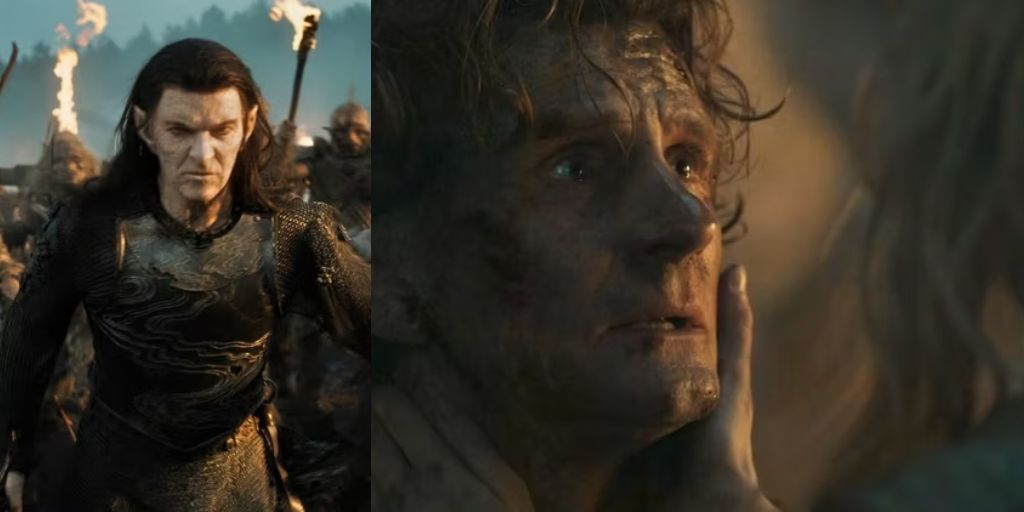The Season 2 finale of The Lord of the Rings: The Rings of Power ends with a huge battle, bringing big changes to Middle-earth. The Elves suffer a terrible defeat, with the loss of their stronghold, Eregion, and one of their greatest leaders, Celebrimbor (Charles Edwards).
Sauron (Charlie Vickers) emerges as a powerful force, taking control of Mordor and leading the Orcs. Meanwhile, the Nine Rings of Men are lost, and Sauron’s grip over Middle-earth tightens.
The destruction of Eregion in the series differs significantly from J.R.R. Tolkien’s original legendarium. In the books, the events surrounding Eregion’s fall are more complex and detailed, involving characters and events that the series has altered or left out.
For instance, Adar (Sam Hazeldine) does not exist in the books, and Sauron is already well-established in Mordor. In the books, Sauron has already forged the One Ring by this time and is likely wearing it during the battle, though the show doesn’t mention it explicitly.
The Rings of Power gives a slightly different interpretation, but the general story of Sauron attacking Eregion for the Rings of Power remains the same.
In Tolkien’s version, after creating the One Ring, Sauron discovers that Celebrimbor secretly made the three Elven Rings. Realizing he’s been tricked, Sauron immediately moves to take control of the Rings.
He launches an assault on Eregion, aiming to seize the Rings of Power. At the same time, the Elves feel the One Ring’s power and understand that they have been betrayed.
Sauron’s forces overwhelm the region. Gil-galad, the High King of the Elves, doesn’t personally join the battle but sends Elrond (Robert Aramayo) with reinforcements.
However, Sauron’s army is too large, and Elrond is blocked from reaching Eregion. He is forced to retreat north with his forces, unable to help the Elves still defending Eregion.
The defense of Eregion falls to Celeborn, who leads the last Elven forces. Celeborn, husband of Galadriel (Morfydd Clark), is fighting to save the kingdom, but it is too late. He and his troops also have to retreat to the north. Sauron’s army wins a crushing victory.

They destroy Eregion, kill Celebrimbor after torturing him for information about the Rings, and learn that the three Elven Rings have been hidden in Lindon.
Sauron, furious at not finding the Rings he sought, uses Celebrimbor’s body as a gruesome banner during the battle.
Although The Rings of Power changes some of these details, it still captures the essence of Sauron’s victory and the destruction of Eregion. In both the books and the series, Sauron’s forces ultimately prevail, and the Elves are forced to flee.
The Dwarves of Khazad-dûm help the Elves escape, much like they do in the series, though their assistance does not last long.
Sauron moves on from Eregion and begins to lay waste to Eriador, a region that remains under his control for a long time. Eventually, Gil-galad, with the help of Númenor, launches a counterattack, driving Sauron back to Mordor.
The adaptation may have taken liberties with some of Tolkien’s lore, but the changes serve to enhance the story’s emotional and dramatic weight.
For example, the introduction of Adar, a character not present in the original works, adds complexity to the narrative. Adar is a dark, yet compelling character. As the leader of the Uruks, he is driven by a desire to free himself and his Orcs from Sauron’s control.
His internal conflict, knowing that true freedom is impossible as long as Sauron exists, adds an extra layer of tension to the storyline.
His right-hand Orc, Glüg (Robert Strange), worries that Adar has lost sight of his original goal. Glüg thinks that if the Orcs are doomed to die fighting Elves, they might as well join forces with Sauron, who could offer them a chance at controlling Middle-earth.
This betrayal of Adar by his own Orcs echoes the sadness of Celebrimbor’s death. It also brings back memories of the opening scenes of Season 2, when Adar led the Orcs in rebellion against Sauron in Forodwaith, early in the Second Age.
This act of defiance created an intriguing character arc for Adar, as someone who, though evil, seeks a form of independence from an even darker force.
In both the books and the series, the fall of Eregion has a lasting impact on Middle-earth. Elrond and his forces are driven north by the Orcs, eventually finding refuge in a secluded valley on the western side of the Misty Mountains. This place is known as the Valley of Imladris, or Rivendell, which becomes Elrond’s new seat of power.
In the original lore, Rivendell replaces Eregion as the key Elven stronghold in the region, alongside Lindon.
Meanwhile, Galadriel and Celeborn cross the Misty Mountains to establish Lothlórien, where they will rule for most of the Second Age.
At the same time, Sauron consolidates his power. In The Rings of Power, Sauron seizes Morgoth’s crown and claims the Nine Rings of Men. In the books, he gains control over the seven Rings of the Dwarves and the Nine Rings of Men.
With these Rings, Sauron sets his plan into motion to dominate Middle-earth. Only the Elves and Númenor stand in his way, with Númenor being the force Sauron fears the most. Over the years, Sauron gives the Rings to their bearers, knowing that they will eventually fall under his control.

The series has made some significant changes to the story of the Rings of Power, but it remains true to the central themes of Tolkien’s work.
The story of Sauron’s rise to power, the fall of Eregion, and the scattering of the Rings is one of tragedy, betrayal, and the slow, inevitable domination of Middle-earth by the Dark Lord. These elements are present in both the books and the show, even if the details differ.
Adar’s character brings an interesting new perspective to the lore, especially as he struggles to break free from Sauron’s influence. His tragic downfall, betrayed by his own Orcs, adds emotional depth to the series.
The relationship between Adar and his Orcs also introduces a fresh dynamic, showing the internal struggles of even the “evil” characters in the story. These changes and additions enrich the narrative and provide new layers of meaning for viewers, even if they deviate from Tolkien’s original text.
In the end, the Sack of Eregion is a turning point for Middle-earth. The loss of Eregion and Celebrimbor, the rise of Rivendell, and the looming threat of Sauron’s control set the stage for the conflicts that will follow.
As the series continues, viewers can expect to see even more of Sauron’s plan unfold, as he moves closer to his goal of dominating the Free Peoples of Middle-earth.
The devastating fall of Eregion marks a significant shift in the power dynamics of Middle-earth. The Elves, who once wielded great influence, are now on the defensive. As Rivendell rises from the ashes of Eregion, it becomes a refuge and a new center of Elven strength.
Meanwhile, Sauron’s conquest of Eriador brings a wave of darkness that spreads throughout the land. The creation of the Nine Rings for Men sets his plans into motion, as he seeks to corrupt and control the rulers of Middle-earth, inching closer to his ultimate goal: complete dominion.





